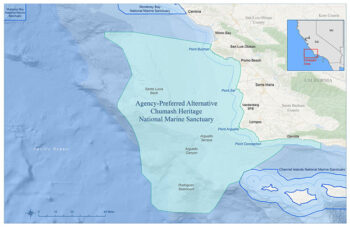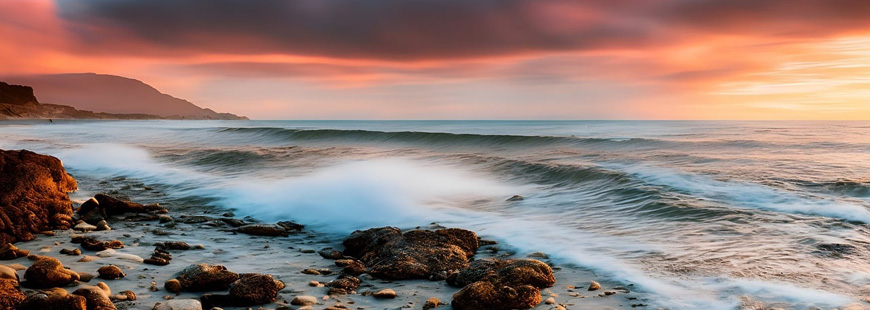On August 25, the National Oceanic and Atmospheric Administration announced a 60-day comment period (ends October 25) on the proposed Chumash Heritage National Marine Sanctuary draft management plan and environmental impact statement (EIS), which will determine the final boundaries, permitted activities, and general regulations of the marine sanctuary. NOAA is hosting in-person and virtual informational workshops to explain their proposed action and answer questions. They will also host public comment meetings on the proposed designation.

Map of the Agency-Preferred Alternative boundary of the area NOAA is proposing to designate as Chumash Heritage National Marine Sanctuary. View maps of draft EIS boundary alternatives
“Designating Chumash Heritage National Marine Sanctuary is a transformational moment for our coastal California waters and all stewards of our shared ocean. This indigenous-led nomination advances ocean justice and equity by protecting ancestral waters and giving everyone the opportunity to learn from the Central Coast Tribes’ traditional knowledge and ways of stewarding cultural and marine resources,” said Joel R. Johnson, president and CEO of the National Marine Sanctuary Foundation.
“The proposed sanctuary would also close a biodiversity protection gap along the California coast. Blue whales, leatherback sea turtles, black abalone and southern sea otters are just a few of the species gaining new habitat protection. People will benefit in many ways too; the proposed sanctuary is also a nursery for fish species we rely on commercially too. We applaud NOAA and the Administration for advancing this sanctuary nomination and we encourage final designation of these magnificent ancestral waters.”
Here Is some of what NOAA is proposing:
- The boundary of the proposed sanctuary would stretch along 134 miles of coastline from Montaña de Oro State Park in San Luis Obispo County to Naples, California, along the Gaviota Coast in Santa Barbara County and would encompass 5,617 square miles.
- The preferred boundary excludes a wide area that could serve as a corridor for the industrial development associated with offshore wind energy production that may not be compatible with a national marine sanctuary depending.
- The preferred boundary allows NOAA to focus its management on key areas historically important to the Chumash tribes and natural resources important to their heritage.
- The proposed sanctuary protects the incredible ecological qualities of the area and would be the first new sanctuary since 1994 managed for biodiversity conservation as part of the National Marine Sanctuary System.
- The draft management plan includes a framework for tribal and Indigenous collaborative management, providing a unique and special opportunity to involve, recognize, and celebrate Indigenous peoples’ values, knowledge, traditions, and modern day and cultural connections to the area.
- Sanctuary designation would come with some regulations that protect habitat and species, and water quality, for example, while also allowing for human uses that are compatible with resource protection. Proposed regulations mirror those found at adjacent sanctuaries.
- The draft environmental impact statement identifies many beneficial impacts from designating the sanctuary, specifically to physical resources biological resources; commercial fishing and aquaculture; cultural heritage and maritime heritage resources; socioeconomics, human uses and environmental justice; and Department of Defense and Department of Homeland Security activities. These benefits would result from sanctuary regulations that would limit the scale and scope of offshore development activities and other human uses that could harm the natural, historical, and cultural resources within the sanctuary.
- The sanctuary designation would conserve the area’s rich biodiversity and create new opportunities for scientific research, education, and economic development, including responsible recreation and tourism. The opportunity to raise public awareness of tribal and Indigenous cultures, incorporate Indigenous knowledge into sanctuary management, and protect resources essential to these cultures, was a core motivation in the sanctuary’s nomination.
This action by NOAA’s Office of Marine Sanctuaries continues the process towards designating the Chumash Heritage National Marine Sanctuary. Following the public comment period, NOAA will prepare the final documents and review them with the State of California’s officials and the U.S. Congress. Official designation action will take place after that review.
The Network will follow the progress of the proposed Chumash Heritage National Marine Sanctuary and provide updates as actions warrant.


